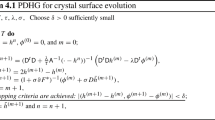Abstract
In this paper we are concerned with the computation of a liquid crystal model defined by a simplified Oseen-Frank energy functional and a (sphere) nonlinear constraint. A particular case of this model defines the well known harmonic maps. We design a new iterative method for solving such a minimization problem with the nonlinear constraint. The main ideas are to linearize the nonlinear constraint by Newton’s method and to define a suitable penalty functional associated with the original minimization problem. It is shown that the solution sequence of the new minimization problems with the linear constraints converges to the desired solutions provided that the penalty parameters are chosen by a suitable rule. Numerical results confirm the efficiency of the new method.
Similar content being viewed by others
References
Alouges, F.: A new algorithm for computing liquid crystal stable configurations: the harmonic mapping case. SIAM J. Numer. Anal. 34, 1708–1726 (1997)
Alouges, F.: A new finite element scheme for Landau-Lifchitz equations. Discret. Contin. Dyn. Syst. Ser. S1(2), 187196 (2008)
Bartels, S.: Stability and convergence of finite element approximation schemes for harmonic maps. SIAM J. Numer. Anal. 43, 220–238 (2005)
Bartels, S.: Numerical analysis of a finite element scheme for the approximation of harmonic maps into surfaces. Math. Comp. 79, 1263–1301 (2010)
Barrett, J., Feng, X., Prohl, A.: On p-harmonic map heat flows for 1 ≤ p < ∞ and their finite element approximations. SIAM J. Math. Anal. 40(4), 1471C1498 (2008)
Bethuel, F., Brezis, H., H́elein, F.: Ginzburg-Landau vortices. Progress in Nonlinear Differential Equations and their Applications, vol. 13. Birkhauser Boston, Inc, Boston (1994)
Brezis, H.: The interplay between analysis and topology in some nonlinear PDE problems. Bull. Amer. Math. Soc. 40, 179–201 (2003)
Chen, Y., Struwe, M.: Existence and partial regularity results for the heat flow for harmonic maps. Math. Z. 201, 83–103 (1989)
Chen, X.: Global and superlinear convergence of inexact Uzawa methods for saddle-point problems with nondifferentiable mappings. SIAM J. Numer. Anal. 35, 1130–1148 (1998)
E, W., Wang, X.: Numerical Methods for the Landau-Lifshitz equation. SIAM J. Numer. Anal. 38, 1647–1665 (2000)
Glowinski, R., Lin, P., Pan, X.: An operator-splitting method for a liquid crystal model. Comput. Phys. Commun. 152, 242–252 (2003)
Hélein, F.: Régularité des applications faiblement harmoniques une surface et une variété riemannienne. C. R. Acad. Sci. Paris 312, 591–596 (1991)
Hélein, F.: Maps harmonic conservation laws and moving frames. Cambridge University Press, Cambridge (2002)
Hu, Q., Tai, X.-C., Winther, R.: A saddle-point approach to the computation of harmonic maps. SIAM J. Numer. Anal. 47, 1500–1523 (2009)
Hu, Q., Zou, J.: Nonlinear Inexact Uzawa Algorithms for Linear and Nonlinear Saddle-point Problems. SIAM J. Optim. 16, 798–825 (2006)
Luo, C., Majumdar, A., Erban, R.: Multistability in planar liquid crystal wells. Phys. Rev. E 85(6) (2012)
Pierre, M.: Newton and conjugate gradient for harmonic maps from the disc into the sphere. ESAIM: Control Optimisation Calc. Var. 10(1), 142–167 (2004)
Polyak, B.T.: Introduction to Optimization. Optimization Software. Inc., Publications Division, New York (1987)
Vanselow, R.: About Delaunay triangulations and discrete maximum principles for the linear conforming FEM applied to the poisson equation. Appl. Math. 46(1), 13–28 (2001)
Xu, J.: Iterative methods by space decomposition and subspace correction. SIAM Rev. 34, 581–613 (1992)
Author information
Authors and Affiliations
Corresponding author
Additional information
Communicated by: Silas Alben.
Qiya Hu was supported by the Major Research Plan of Natural Science Foundation of China G91130015, The Key Project of Natural Science Foundation of China G11031006 and National Basic Research Program of China G2011309702.
Rights and permissions
About this article
Cite this article
Hu, Q., Yuan, L. A newton-penalty method for a simplified liquid crystal model. Adv Comput Math 40, 201–244 (2014). https://doi.org/10.1007/s10444-013-9305-4
Received:
Accepted:
Published:
Issue Date:
DOI: https://doi.org/10.1007/s10444-013-9305-4




